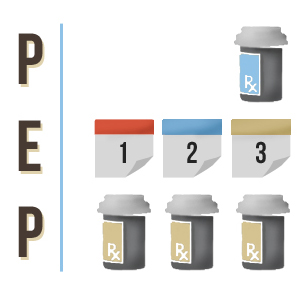What Is Post-Exposure Prophylaxis?
PEP involves taking anti-HIV drugs as soon as possible after you may have been exposed to HIV to try to reduce the chance of becoming HIV positive. There are two types of PEP: (1) occupational PEP, (sometimes called "oPEP"), and (2) non-occupational PEP, (sometimes called “nPEP”). Workplace exposure (oPEP) is when someone working in a health-care setting is potentially exposed to material infected with HIV. nPEP is when someone is potentially exposed to HIV outside the workplace (e.g., condom breakage, sexual assault, etc.)
To be effective, PEP must begin within 72 hours of exposure, before the virus has time to rapidly replicate in your body. PEP consists of 2-3 antiretroviral medications and should be taken for 28 days. Your doctor will determine what treatment is right for you based on how you were exposed to HIV. The medications have serious side effects that can make it difficult to finish the program. PEP is not 100% effective; it does not guarantee that someone exposed to HIV will not become infected with HIV.
Who Needs PEP?
PEP is usually used for anyone who may have been exposed to HIV.
Healthcare workers have the greatest risk. They can be exposed to HIV by:
- Needle sticks or cuts
- Getting blood or other body fluids in their eyes or mouth
- Getting blood or other body fluids on their skin when it is chapped, scraped, or affected by dermatitis
The risk of HIV transmission in these ways is extremely low—less than 1% for all exposures.
PEP can also be used to treat people who may have been exposed to HIV by accident (e.g., condom breakage) or sexual assault.
When Should I Take PEP if I’ve Been Exposed?
PEP is most effective if you take it within 72 hours of possible HIV exposure. The longer you wait to start PEP, the greater the risk of becoming HIV-positive.
Your healthcare provider will consider whether PEP is right for you based on how you might have been exposed and whether you know for sure that the individual who might have exposed you is HIV-positive. You may be asked to return for more HIV testing at 4 to 6 weeks, 3 months, and 6 months to determine your HIV status.
For more information, see the National Institutes of Health’s Health-Care Worker Exposure Guidelines or Nonoccupational Exposure Considerations.
Where Can I Get PEP?
Some of the places you can go to seek treatment include your doctor’s office, emergency rooms, urgent care clinics, or a local HIV clinic.
Fact Sheets & Print Materials
- CDC - Fact Sheet: Preventing Occupational HIV Transmission to Healthcare Personnel
- AIDS.org – Treatment After Exposure to HIV (PEP)

- New York State Department of Health AIDS Institute – Post-Exposure Prophylaxis Quick Reference Card (2008) (PDF)

Related Topics on AIDS.gov
Frequently Asked Questions
If I keep having unprotected sex with an HIV-positive partner, can I keep taking PEP to stay safe?
No. The CDC does not recommend taking PEP in the event of repeated unprotected sex with an HIV-positive partner. Researchers believe that if you use PEP repeatedly, the side effects of the meds could put a strain on your immune system and make you more susceptible to HIV infection.
Why can’t PEP therapy be taken after 72 hours from the point of exposure?
HIV grows faster and faster once it enters your body. If you start taking PEP more than 72 hours after exposure, the meds can’t keep up, and research has shown that PEP has little or no effect in preventing HIV infection after the 72-hour mark.
Additional Resources
- The Body – Post-Exposure Prevention

- WHO – More Information About PEP for HIV

- CDC - Updated U.S. Public Health Service Guidelines for the Management of Occupational Exposures To HBV, HCV, and HIV and Recommendations for Postexposure Prophylaxis
- AIDSinfo - Health-Care Worker Exposure Guidelines
- AIDSinfo - Nonoccupational Exposure Considerations
- CDC - Antiretroviral Postexposure Prophylaxis After Sexual, Injection-Drug Use, or Other Nonoccupational Exposure to HIV In the United States
- CDC - HIV In Healthcare Settings
- Occupational Safety & Health Administration (OSHA) - Bloodborne Pathogens and Needlestick Prevention
- New York State Department of Health AIDS Institute – HIV Prophylaxis Following Occupational Exposure (2010) (PDF)

- New York State Department of Health AIDS Institute – HIV Prophylaxis Following Non-Occupational Exposure Including Sexual Assault (2010) (PDF)

Last revised: 05/19/2011



